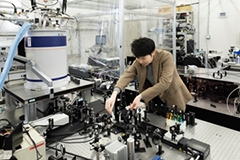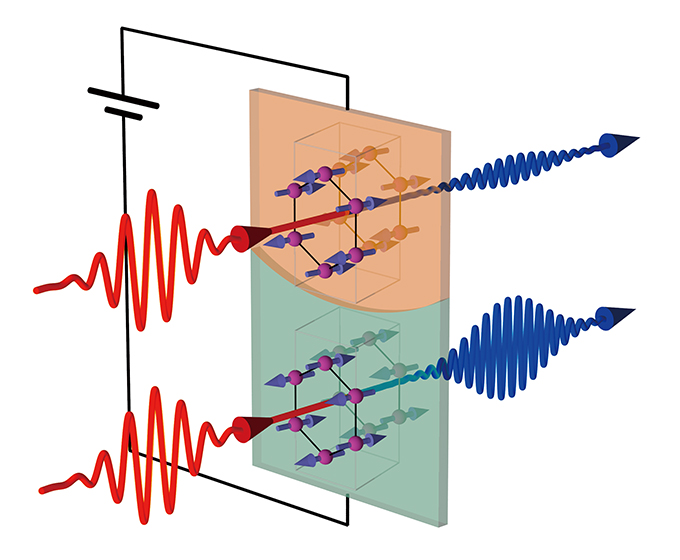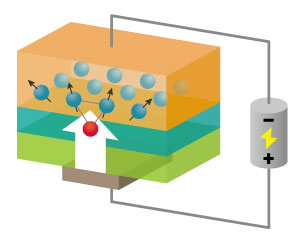
Our group explores novel photodynamics of electron/spin/lattice in bulk crystals and at thin-film interfaces emerging via electron-correlation, strong spin-orbit interaction, and topology. Examples are ultrafast spectroscopy on shift/injection current, generation of spin current mediated by Dirac/Weyl electrons, and manipulation of topological magnetic textures. With a strong command of photons, we try to realize new photo-electric/magnetic effects in solids, and visualize spatiotemporal propagation of various elemental excitations at the sub-diffraction limit.
Electric-filed control of domain contrast and nonreciprocity in a van-der-Waals antiferromagnet
Effective control of nonreciprocal optical responses is crucial in all-optical devices. Until recently, such control largely relies on external magnetic fields, requiring bulky device structures with slow response time. We demonstrate a general strategy for modifying nonreciprocal optical second-harmonic generation (SHG) by using electric fields, offering a compact structure, fast response, and a substantial tuning range of ±90% in van der Waals antiferromagnet MnPS3 as proof-of-concept. In our experiment, microscopic SHG imaging was performed on sample flakes with an electric field applied in specific crystallographic direction, at varying excitation photon energy, polarization and sample temperature. Antiferromagnetic (time-reversal) domains in MnPS3 were found to exhibit distinct contrast originating from nonreciprocity, which changes with the applied electric field. By further analyses on the polarimetry, we revealed that this effect originates from the interference between electric-dipole, magnetic-dipole, and electric-field-induced SHG sources, consistent with our theoretical design based on symmetry.

Schematic illustration of time-reversal domains in an antiferromagnet and corresponding nonreciprocal SHG.
Optical diode effect in second harmonic generation
In multiferroic materials where spatial-inversion and time-reversal symmetries are simultaneously broken, optical responses can change by reversing the direction of light propagation. This nonreciprocal effect has been realized in various linear optical responses, such as transmission, emission, scattering, and refraction. We investigate the nonreciprocal effects in nonlinear optical processes, specifically second harmonic generation (SHG) in CuB2O4. Generally, nonreciprocal effects are negligibly small, because their origin is an interference between magnetic and electric dipole transitions, where the former is intrinsically much smaller than the latter. We found that the magnetic dipole transition in CuB2O4 can be enhanced extremely due to optical resonance, leading to the magnitude comparable to that of the electric dipole one under the non-resonant condition. As a result, these two transitions interfere with each other in the same phase and amplitude, resulting in an almost perfect nonlinear nonreciprocal effect with 97% change in the SHG intensity. We also demonstrated that the light direction with the larger SHG intensity can be controlled by reversing a magnetic field of only 10 mT.

(Left) Schematic illustration of nonreciprocal SHG. (Right) Magnetic field dependence of SHG intensity.
Ultrafast spectral dynamics of shift current
Shift current refers to the photocurrent in materials with broken inversion symmetry, originating from the spontaneous shift of electron clouds in real-space via the topological nature of the electronic bands. It is distinct from conventional photovoltaic effect where the interfaces of semiconductors are employed; shift current emerges in bulk crystals at ultrafast time-scale without much dissipation, in many cases accompanied by large open-circuit voltage exceeding the band gap energy. We have unveiled the ultrafast spectral dynamics of the shift current by detecting THz electromagnetic waves generated through its carrier motion. The shift current is found to appear faster than the experimental time-resolution (~100 fs) with a tensor response to the incoming photon polarization, and shows distinct time profile from that of the optical rectification. Importantly, the experimental shift current nicely compares with the spectra deduced from first-principles calculations based only on the crystal structures.

Schematic illustration of the THz emission via photoexcited shift current.
Photoinduced dynamics in topological spin textures
High-speed magnetic memories and photonic-magnonic interconnections will be realized by using the pulsed-optical-control of spins. For this purpose, the inverse-Faraday effect, one of the optomagnetic phenomena, is promising, where circularly-polarized laser pulses at non-absorbing photon energy can induce effective magnetic fields via strong spin-orbit interactions. We demonstrated that the collective dynamics of magnetic skyrmions, topologically-protected nano-scale spin vortices, can be characterized by using the inverse-Faraday excitation and time-resolved magneto-optics with sub-picosecond time-resolution. We also found that magnetoelastic waves, coupled propagation of magnon and phonon, can be excited in iron garnet films by photoexcitation. The time-resolved microscopy on the magnetoelastic wave revealed that this traveling spin excitation shows an attractive interaction with magnetic bubbles (skyrmions) and domain walls, whose efficiency strongly depends on the curvature of the local spin texture.

(a) Schematics for the impulsive Raman excitation.
(b) Rotation dynamics of magnetic skyrmions in Cu2OSeO3.
(c) Magneto-optical microscopy on photoexcited magnetoelastic waves.
(d) Optical manipulation of a magnetic bubble domain.










